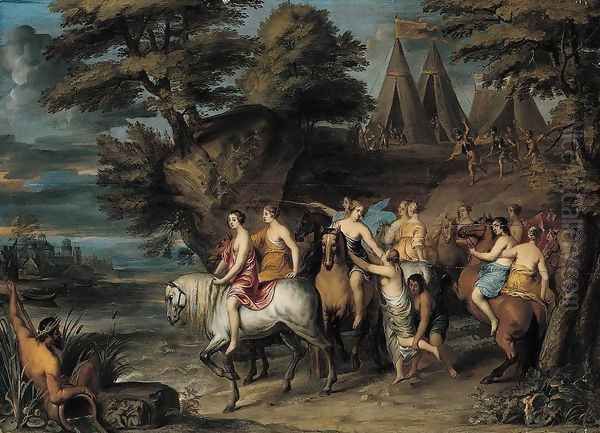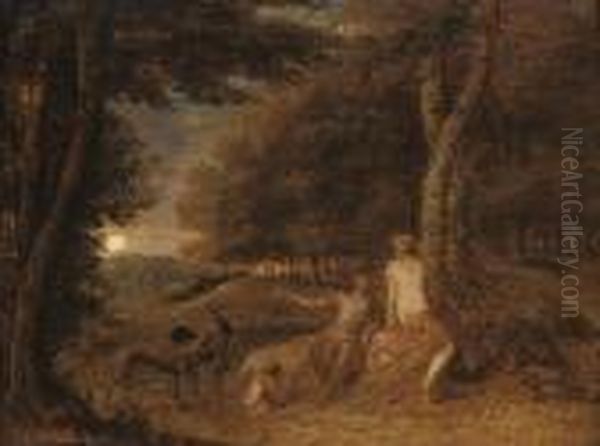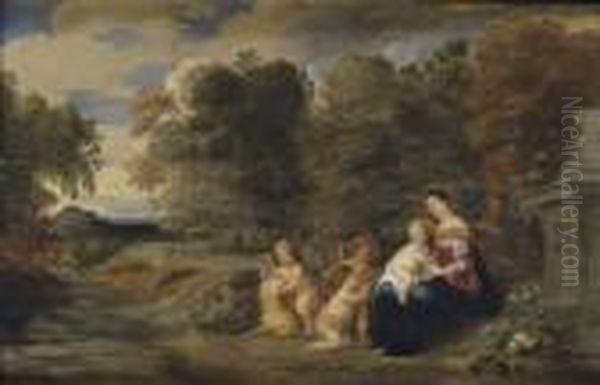
Frans Wouters (1612-1659) stands as a notable, if sometimes overlooked, figure in the vibrant tapestry of Flemish Baroque art. Born in Lier, a town near the bustling artistic hub of Antwerp, Wouters carved out a career that saw him learn from prominent masters, collaborate with the titan Peter Paul Rubens, serve European nobility, and develop a distinct specialization in cabinet paintings, often imbued with mythological and biblical narratives set within delicate landscapes. His life, though tragically cut short, reflects the dynamic artistic exchanges and patronage systems of 17th-century Europe.
Early Training and Artistic Foundations
Frans Wouters' artistic journey began in a period of immense artistic fecundity in the Southern Netherlands. Antwerp, in particular, was a powerhouse, with workshops teeming with talent, all largely orbiting the colossal figure of Peter Paul Rubens. Wouters' initial formal training, however, was under Pieter van Avont, a painter known for his small-scale religious and mythological scenes, often featuring numerous figures in landscape settings. Wouters is documented as a pupil of van Avont from around 1629. Van Avont's penchant for detailed, smaller works likely provided a foundational influence on Wouters' later preference for cabinet-sized paintings.
The workshop of a master like van Avont would have provided a comprehensive education. Young artists learned to grind pigments, prepare panels and canvases, and master the fundamentals of drawing and composition by copying works of their master and other renowned artists. This period under van Avont, which lasted until about 1634, would have equipped Wouters with the technical skills necessary to embark on a professional career. The themes favored by van Avont – idyllic landscapes populated with biblical or mythological figures – clearly resonated with Wouters and became a recurring feature in his own oeuvre.
In the Orbit of Peter Paul Rubens

A pivotal moment in Frans Wouters' career came in 1634 when he transitioned to the workshop of Peter Paul Rubens. To be accepted into Rubens's studio was a mark of considerable promise. Rubens was not merely a painter; he was an international celebrity, a diplomat, and the head of a highly efficient, factory-like workshop that produced an astonishing volume of art for patrons across Europe. Assistants and collaborators in Rubens's studio were involved in various stages of production, from laying in initial compositions based on Rubens's oil sketches (bozzetti) to painting backgrounds, drapery, or secondary figures on large-scale canvases.
Wouters' role in Rubens's workshop, while not as prominent as that of figures like Anthony van Dyck or Jacob Jordaens before they established their independent careers, was nonetheless significant. He is documented as one of the many artists who collaborated on the monumental decorations for the Triumphal Entry (Pompa Introitus Ferdinandi) of the Cardinal-Infante Ferdinand of Austria into Antwerp in 1635. This massive undertaking, orchestrated by Rubens, involved creating temporary triumphal arches and stages adorned with allegorical paintings celebrating the new governor of the Spanish Netherlands. Wouters' participation in such a prestigious project, even as a contributing hand, would have been an invaluable experience, exposing him to large-scale decorative painting and the complex iconographic programs devised by Rubens.
The influence of Rubens on Wouters is undeniable, though it manifested differently than in artists who primarily emulated Rubens's grand manner. Wouters absorbed Rubens's dynamic compositions, his rich color palette, and his sensuous rendering of figures, but he typically translated these elements into a more intimate, smaller scale suitable for cabinet paintings. The elder master's impact can be seen in the fluidity of Wouters' figures and the lively integration of figures within their landscape or architectural settings. Other artists from Rubens's circle, such as Frans Snyders (animal painter), Jan Wildens (landscape painter), or Cornelis Schut and Theodoor van Thulden, who also worked on the Pompa Introitus, formed part of this vibrant artistic milieu.
Independent Master and Early Commissions
In the guild year 1634-1635, Frans Wouters was registered as a master in the Antwerp Guild of Saint Luke. Membership in the guild was essential for any artist wishing to practice independently, take on pupils, or sell their work publicly in Antwerp. This milestone marked his official entry into the professional art world as an autonomous artist.

His early independent works continued to show the influence of both van Avont and Rubens. He specialized in mythological, allegorical, and biblical scenes, often set in lush, wooded landscapes. These were popular themes among collectors, allowing for depictions of the human form, dramatic narratives, and the beauty of nature. His style was characterized by a refined touch, delicate brushwork, and a harmonious, if sometimes somewhat cooler, color palette compared to Rubens's fiery tones. He shared this thematic preference with many contemporaries, including Abraham Janssens before him, and younger artists like Thomas Willeboirts Bosschaert or Jan Boeckhorst (also known as Lange Jan), another Rubens collaborator.
Court Painter to Emperor Ferdinand II
A significant advancement in Wouters' career occurred when he attracted the attention of Emperor Ferdinand II of the Holy Roman Empire. Around 1637, Wouters was appointed court painter to the Emperor in Vienna. This was a prestigious position that offered not only financial stability but also enhanced status. Court painters were expected to produce portraits, allegorical works celebrating the ruler, and other pieces as required. While the specifics of his output for Ferdinand II are not extensively documented, this appointment underscores his growing reputation.
His time in Vienna, however, was relatively brief, as Emperor Ferdinand II died in 1637. Despite the short tenure, the imperial connection was a valuable asset. It's possible that during this period, or through connections made there, his work became known to other influential patrons. The art scene in Central Europe, while distinct from Antwerp, had its own rich traditions, with artists like Bartholomeus Spranger having earlier established a strong Mannerist school in Prague under Emperor Rudolf II.
Sojourn in England and Royal Patronage
Following his imperial service, Frans Wouters traveled to England. He arrived around 1637-1638, during a period when the English court, under King Charles I, was a major center of art patronage. Charles I was a discerning collector, and his court was graced by the presence of Anthony van Dyck, who had revolutionized English portraiture. Wouters entered the service of the Prince of Wales, the future King Charles II.
In England, Wouters continued to paint mythological and landscape scenes. His style, with its refined elegance and smaller scale, would have appealed to the tastes of aristocratic collectors who appreciated cabinet pictures for private contemplation. The English art scene at this time also included native talents like William Dobson and foreign artists such as Gerrit van Honthorst (who had an earlier, influential visit) and Orazio Gentileschi. Wouters' Flemish training and his association with Rubens would have lent him a certain cachet. He remained in England until approximately 1641. His departure coincided with the escalating political tensions that would soon lead to the English Civil War, a conflict that severely disrupted artistic patronage and led many foreign artists to leave the country.
Return to Antwerp and Later Career

Upon his return to Antwerp around 1641, Frans Wouters re-established himself in the city's vibrant art scene. He resumed his membership in the Guild of Saint Luke and became an active figure. In 1644, he married Maria Doncker, who was the daughter of a prominent Antwerp citizen, further cementing his social standing.
His artistic output during this period continued to focus on his specializations. He produced numerous cabinet paintings depicting mythological scenes such as Venus and Adonis, Diana and Actaeon, or The Abduction of Europa, often characterized by slender, graceful figures set against detailed woodland backdrops. These works found a ready market among Antwerp's affluent citizenry and international merchants. His landscapes, sometimes featuring ruins or classical architecture, show an attention to detail and atmospheric effect. While he was not primarily a landscape specialist in the vein of Jan Brueghel the Elder or Younger, or Lucas van Uden, landscape played a crucial role in his compositions, creating the mood and setting for his narratives.
Beyond his own painting, Wouters also engaged in the art trade, a common practice for artists at the time. His expertise was recognized when, following the death of Peter Paul Rubens in 1640, Wouters was involved in the valuation of the artworks in Rubens's estate. This was a complex and significant task, given the vast collection Rubens had amassed, and Wouters' participation speaks to his respected position within the Antwerp art community. He also held an administrative role within the Guild of Saint Luke, serving as its dean in 1649, a position of leadership and responsibility.
Artistic Style and Representative Works
Frans Wouters' style is best described as a refined and elegant iteration of Flemish Baroque, adapted for the intimate scale of cabinet painting. His figures are typically slender and graceful, with elongated proportions, reminiscent of some Mannerist tendencies but imbued with a Baroque sense of movement and emotion. His brushwork is generally smooth and meticulous, allowing for fine detail in foliage, fabrics, and figures.
His color palette often favors cooler tones – blues, greens, and silvery grays – especially in his landscapes, though he could employ warmer colors for flesh tones and dramatic accents, a legacy of his time with Rubens. The influence of his first master, Pieter van Avont, can be seen in the somewhat sweet expressions of his figures and the idyllic quality of many of his scenes. However, the dynamism and compositional sophistication often reflect the lessons learned from Rubens.

One of his notable works is Cloelia and Her Companions Escaping from the Etruscans. This painting depicts a dramatic episode from early Roman history where the hostage Cloelia leads a group of Roman maidens to freedom by swimming across the Tiber River, away from the Etruscan camp of Lars Porsenna. Wouters captures the urgency and bravery of the scene, with figures in dynamic poses, set against a riverine landscape. The composition effectively conveys the narrative, a hallmark of successful history painting.
Other typical subjects include:
Mythological Scenes: Venus and Adonis, Diana and Callisto, The Judgment of Paris, Pan and Syrinx. These subjects allowed for the depiction of the nude or semi-nude figure in a classical context.
Biblical Scenes: While perhaps less frequent than mythological ones, he did paint religious subjects, often on a small scale suitable for private devotion.
Allegorical Landscapes: Landscapes that carry symbolic meaning, often populated by mythological or allegorical figures.
His works are often characterized by a certain delicacy and charm, distinguishing them from the more robust and monumental works of many of his contemporaries who focused on larger altarpieces or decorative cycles, such as Gaspar de Crayer or Abraham van Diepenbeeck. Wouters found his niche in creating beautifully crafted objects for connoisseurs and private collectors.
Tragic End and Legacy
Frans Wouters' promising career and life were tragically cut short. In 1659, he died in Antwerp as a result of an accidental gunshot wound. He was only in his late forties. This premature death undoubtedly limited the full development of his artistic potential and the volume of his oeuvre.
Despite his relatively short life, Frans Wouters made a discernible mark on Flemish art. He successfully navigated the competitive art world of Antwerp, benefiting from the tutelage of significant masters and securing prestigious international patronage. His specialization in cabinet paintings, particularly mythological landscapes, catered to a growing demand for smaller, collectible artworks.
Today, works by Frans Wouters can be found in various museums and private collections, including the Royal Museum of Fine Arts Antwerp, the Prado Museum in Madrid, and others. While he may not possess the towering fame of Rubens or Van Dyck, he is recognized as a skilled and sensitive painter who contributed to the richness and diversity of the Flemish Baroque tradition. He represents a successful adaptation of the grand Rubensian style to a more intimate and personal mode of expression, creating works that were admired for their elegance, craftsmanship, and narrative charm. His career also illustrates the mobility of artists in the 17th century and the interconnectedness of European courts and artistic centers. He remains an important example of a "second-generation" Flemish Baroque artist who built upon the foundations laid by the giants of the preceding era.